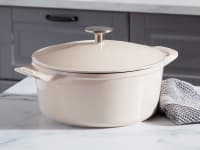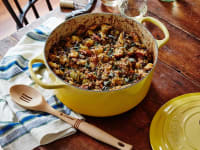Is a steam bath the secret to baking better bread?
We baked a few loaves to find out.
Products are chosen independently by our editors. Purchases made through our links may earn us a commission.
Whether you’re making rustic country loaves or are about to jump on the sourdough artisan bread bandwagon, you may be curious about the best ways to go about your baking—should you invest in a Dutch oven?
Though the most set-it-and-forget-it way is to ask a Dutch oven for help, many traditionalists argue the size and shape of a Dutch oven limits the types of bread they can make (baguettes and dinner rolls will surely be out of the picture)—and, depending on the degree of fermentation, the bread baked in a Dutch oven may not generate enough oven spring for the bread to have the perfect crust and airy crumb.
How does a steam bath work?
Unlike some European kitchens that are equipped with ovens that can inject steam, American ovens normally don’t have such fancy functions. So, how does the presence of a steam bath affect the result when baking bread? Are there ways to manually add steam to a conventional oven?
Within minutes of entering a hot oven, the still-active yeast in the dough releases gas and causes the dough to rapidly expand in volume. This final rising of the dough, before the crust begins to form, is known as “oven spring.”
If steam is added to the otherwise dry air in the oven (or trapped in a Dutch oven as it evaporates off the wet dough), it condenses on the exterior of the dough, forming a film of water that prevents the surface from drying out into a crisp crust before the dough can freely expand.
As Harold McGee points out in On Food and Cooking, there are two main benefits of a steam bath and the oven spring it enables in bread making. First, the overall result is a larger, lighter loaf with airy crumb. Second, the hot water film gelates starch at the loaf surface into a thin, transparent coating that later dries into an attractively glossy crust.
How to add steam while making bread with a Dutch oven
The easiest way to add steam to your bread is to trap it—which is why a Dutch oven can be convenient and useful. Preheat the pot, put in the dough, bake with the lid on for 15 minutes, then remove the lid.
As Dutch ovens are known for their ability to retain heat, very few temperature fluctuations will occur throughout baking. These simple steps can guarantee your loaves of bread to have a crusty exterior.
How to add steam while making bread without a Dutch oven
There are also ways to create additional steam while baking if you don’t own a Dutch oven. You may have heard about using a spray bottle to spray the back of the oven when it’s done preheating. It’ll help create some steam immediately but this method has disadvantages, as it’ll interfere with the oven temperature and produce a limited amount of steam.
A more complicated but consistent way to generate steam in your home oven involves lava rocks, boiling water, and familiarity with the steam bath regimen.
First, preheat the oven with a baking sheet filled with lava rocks on the bottom rack and a baking stone on the mid-level rack. Once the oven finishes preheating, place the proofed dough on the baking stone. Then, carefully pour boiling water onto the lava rocks as quick as possible and close the oven door.
Be aware of steam burns—wear oven mitts on both hands and choose oven mitts that have coverage on your lower arms. To make sure the hot water won’t splash and cause the oven door glass to shatter, place a dry kitchen towel over it before you pour water onto the rocks.
You should practice these steps a few times before you actually bake—it’ll be hard to mess up if they become muscle memory.
The final verdict
If you’re new to making bread from scratch and only bake one style of bread, then baking in a Dutch oven may be the easiest, most convenient approach. A high-quality Dutch oven has an airtight seal with the lid on, which ensures that moisture will stay inside the pot throughout the baking process, allowing for excellent oven spring which will give the surface of the bread a glossy, shiny finish.
However, if you aren’t satisfied with rustic, round loaves and want to explore bread of other types like baguettes and dinner rolls, you may benefit from creating your steam bath by another method. Ovens with a built-in steam function are still rare in the domestic market, but there are many tools and tricks that can help you bypass the need for a fancy oven while not compromising on the quality of your bread.


